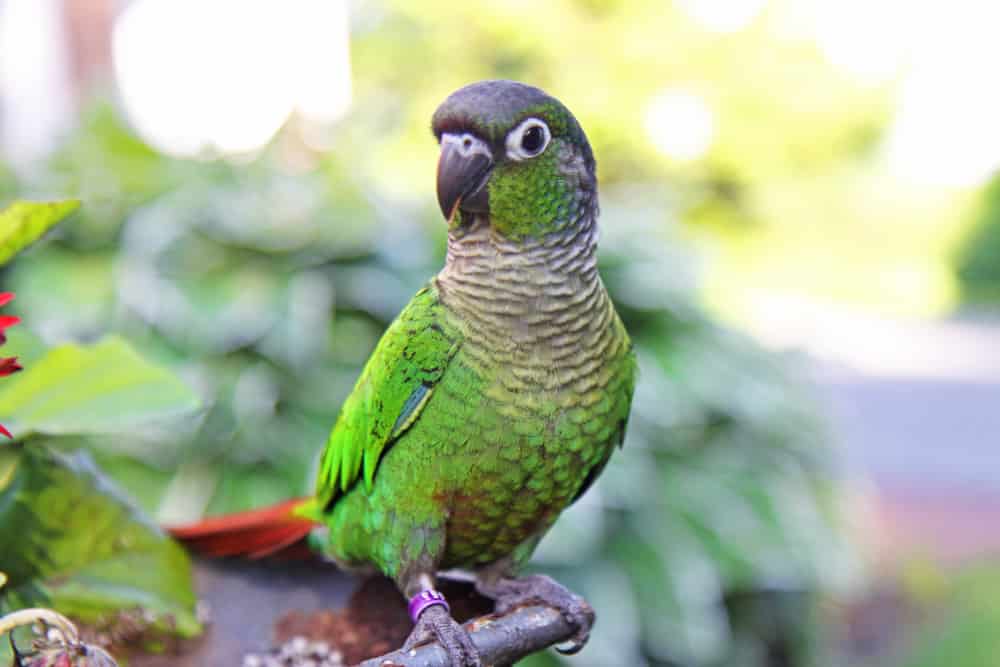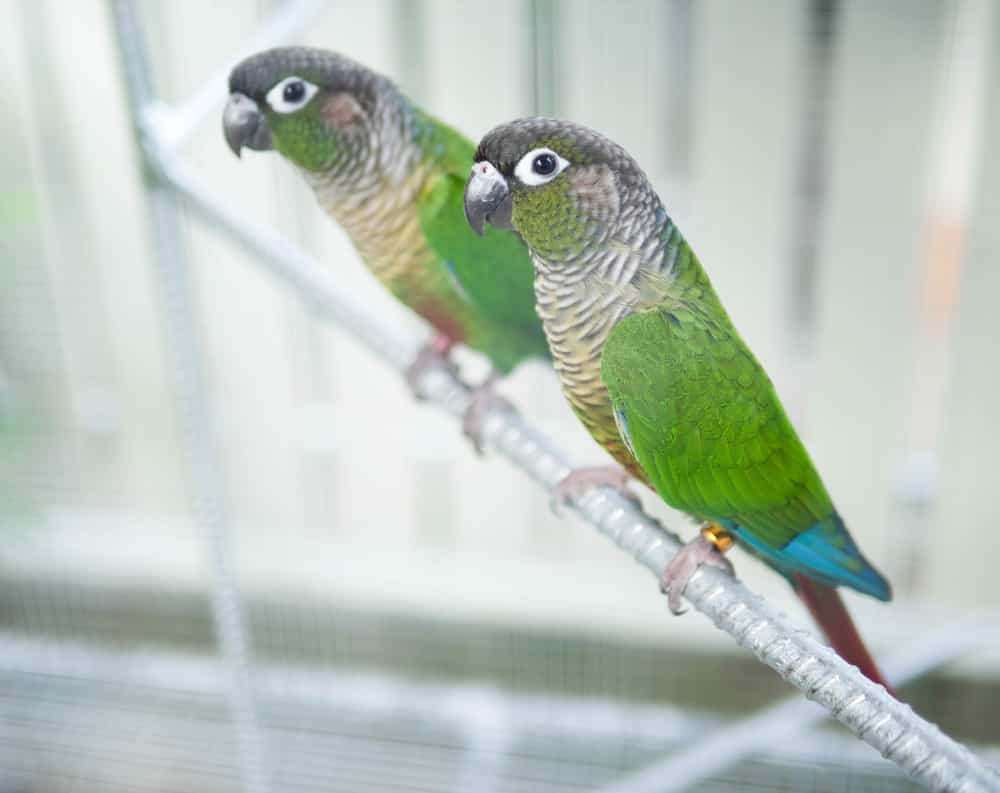
Determining a conure’s gender requires more than just a visual check.
©Christine Snyder/Shutterstock.com
Diving into the vibrant world of Green Cheek Conures? These feathery friends are not just a burst of colors but also personalities. But did you know that the males and females have some subtle (and not-so-subtle) differences? Whether you’re a seasoned bird owner or just starting your journey, understanding these distinctions can be a game-changer.
In this guide, we’ll flutter through the key differences between male and female Green Cheek Conures, from their physical traits to their unique behaviors. So, grab your binoculars (just kidding, you won’t need them), and let’s embark on this enlightening journey together!
Physical Differences Between Male and Female Green Cheek Conures: A Deep Dive
In the vibrant world of Green Cheek Conures, every detail matters. These birds, with their captivating colors and spirited personalities, have subtle differences that can sometimes be overlooked. But for the keen observer or the potential bird parent, understanding these nuances can be both fascinating and essential.
Size: More Than Meets the Eye
At a casual glance, you might think, “A bird is a bird, right?” But when it comes to Green Cheek Conures, there’s a bit more to the story. While both genders generally fall within the same size bracket, a closer look might reveal that males have a slight edge in terms of size. They might just be a bit more robust or have a more pronounced stature.
Feather Coloration: A Symphony of Hues
The world of Green Cheek Conures is a canvas painted with a myriad of colors. Both genders proudly display a spectrum of shades, but the males? They often take center stage with their more vibrant tones, especially around the neck and head regions. It’s as if they’re wearing nature’s crown.
Females, on the other hand, possess a beauty that’s intricately detailed and nuanced. Their plumage is a blend of soft pastels and muted tones, creating a harmonious balance that’s pleasing to the eye. The subtle gradients on their wings and tail feathers, their eyes, often surrounded by a lighter halo, the gentle curve of their beak, and the soft tuft of feathers on their crown further accentuate their charm.
Eye Rings: The Subtle Signifiers
The eyes are often called the windows to the soul, and with Green Cheek Conures, the area around those windows can be quite telling. Have you ever been drawn to the gentle ring that encircles a conure’s eye? This seemingly minor detail can be a gateway to understanding their gender.
Males tend to have a bolder, more defined eye ring, giving them a distinct look. Females, in their delicate beauty, often have a softer, more subtle ring. But nature, in its infinite wisdom, ensures there’s always diversity. So, if you’re ever scratching your head in confusion, reaching out to a bird aficionado or expert can provide clarity.
The world of Green Cheek Conures is filled with nuances and subtleties that make each bird uniquely special. From size disparities to in feather colors and details of eye rings, understanding these differences enriches our appreciation for these avian wonders. Whether you’re a bird enthusiast or considering welcoming one into your home, recognizing these physical differences ensures you’re well-informed and ready to provide the best care for your feathery friends.

In the world of Green Cheek Conures, gender differences are more than skin deep.
©Alpiani/Shutterstock.com
Behavioral Differences in Green Cheek Conures: A Closer Look
Behavior is a fascinating lens through which we can understand and appreciate the unique personalities of creatures, and Green Cheek Conures are no exception. These vibrant birds, with their animated antics and distinct temperaments, offer a world of insights into the avian psyche. Let’s delve deeper into the behavioral nuances that set male and female Green Cheek Conures apart.
Vocalization: The Symphony of Sounds
Picture this: a grand stage set against the backdrop of lush rainforest, with each Green Cheek Conure vying for the spotlight in a melodious showdown. In this harmonious arena, males often emerge as the maestros. Their vocal range is not just about volume but also variety. From chirps to melodies, their vocal cords dance to a richer and more diverse set of tunes. It’s as if they have an innate desire to share their feelings, stories, and moods with the world.
On the flip side, female conures, while equally passionate about their performances, might opt for a slightly more subtle approach. Their songs, though perhaps less varied, are filled with emotion and nuance. It’s a gentle reminder that sometimes, less is more, and simplicity has its charm.
Territorial Behavior: The Nesting Chronicles
The world of Green Cheek Conures is filled with drama, especially when it comes to their homes. Nesting is a serious business, and these birds are not afraid to lay down the law when it comes to their territories. As breeding season approaches, the stage is set for some intense territorial displays.
Females, in particular, channel their inner protective mothers during this time. Their nests are their sanctuaries, and they’ll go to great lengths to defend them. Whether it’s warding off potential threats or ensuring the safety of their eggs, their maternal instincts are a force to be reckoned with.
Males, in contrast, exhibit a range of captivating territorial behaviors. Though they may seem laid-back, their territorial instincts run deep. With the onset of the breeding season, they assert dominance through displays: fanning tail feathers, puffing up their chests, and emitting resonant calls. Their aerial acrobatics signal their territorial claims and they perch near their nests, watching for intruders. Encounters with rival males can lead to brief but intense skirmishes, showcasing their dedication to safeguarding their mate and offspring.
Mating Behavior: The Dance of Love
When it comes to romance, male conures truly shine. Their courtship rituals are nothing short of theatrical. Imagine a male conure, feathers all fluffed up in pride, trying to catch the attention of his potential mate. Their serenades, a mix of melodious tunes and rhythmic beats, are all about wooing and winning over their beloved. It’s a heartfelt performance, where every note and gesture is about expressing love and affection.
Overall, the world of Green Cheek Conures is a blend of melodies, territorial tales, and romantic rendezvous. Understanding these behavioral differences not only deepens our appreciation for these birds but also equips us to cater to their needs better. Whether it’s recognizing their unique vocal expressions, respecting their territorial boundaries, or being a silent spectator to their courtship dances, being attuned to these differences ensures a harmonious coexistence. After all, in the grand opera of life, every bird, be it male or female, has its song to sing and dance to perform.

Green Cheek Conures in courtship: Both males and females play a role in the dance of love.
©Nan_Got/Shutterstock.com
Navigating the Nuances of Green Cheek Conures
Welcoming a Green Cheek Conure into your life is not just about embracing a new companion; it’s about understanding and appreciating the subtle differences and unique traits that define them. Each gender, with its distinct characteristics, offers a world of discovery.
From physical attributes like feather coloration and size to behavioral nuances in vocalization and territorial tendencies, identifying these key differences is crucial. It not only deepens your bond but also ensures you cater to their specific needs effectively.
By thoughtfully considering your lifestyle, ensuring you have the right environment, and dedicating time to understand these differences, you’re setting the stage for a harmonious and enriched relationship.
Life’s beauty often lies in its details, and with Green Cheek Conures, it’s these very differences that make the journey so rewarding. As you embark on this adventure, remember that every observation, every nuance, and every moment of understanding adds a vibrant hue to the tapestry of your shared journey.
Diving Deeper: Unraveling the Most Common Queries About Green Cheek Conures
Green Cheek Conures, with their vivacious personalities and captivating colors, often pique our curiosity. As potential or current bird parents, we naturally have a plethora of questions about these avian wonders. Let’s address some of the most frequently asked questions, shedding light on the intricacies of Green Cheek Conure care and understanding.
1. Determining the Gender: Beyond Just a Guess
Question: How can I definitively determine the gender of my Green Cheek Conure?
Answer: While observing physical traits and behaviors can sometimes give us clues, they’re not foolproof. For a definitive answer, DNA testing is the way to go. It’s a simple process, often requiring just a feather or a blood sample, and offers a clear answer to the gender mystery.
2. Lifespan Insights: A Journey Through Time
Question: Do male and female conures have different lifespans?
Answer: Gender doesn’t play a significant role in the lifespan of Green Cheek Conures. Both males and females, when cared for optimally, can be delightful companions for anywhere between 15 to 20 years. It’s all about the quality of care and love they receive.
3. A Palette of Colors: The World of Mutations
Question: Are there any color mutations in Green Cheek Conures?
Answer: Absolutely! The Green Cheek Conure world is a canvas of colors. From the warm and earthy tones of the cinnamon mutation to the vibrant shades of the pineapple and the serene hues of the turquoise, there’s a spectrum of color mutations to admire and choose from.
4. Cohabitation Queries: Males and Females Under One Roof
Question: Can I keep male and female conures together?
Answer: Yes, you can! But remember, when you put males and females together, nature might just take its course. Breeding could be on the horizon. So, if you’re considering this setup, it’s essential to be prepared for potential baby conures and ensure you have the right environment and resources for birdie parenthood.
5. The Health Mantra: Ensuring a Vibrant Life
Question: How can I ensure my conure lives a healthy life?
Answer: Think of it as a three-pronged approach: nutrition, health care, and affection. Offering a balanced diet ensures they get the right nutrients. Regular vet check-ups help in the early detection of potential health issues. And, of course, a generous dose of love and attention keeps their spirits high and hearts happy.
The photo featured at the top of this post is © Jida Xu/Shutterstock.com
Thank you for reading! Have some feedback for us? Contact the AZ Animals editorial team.







